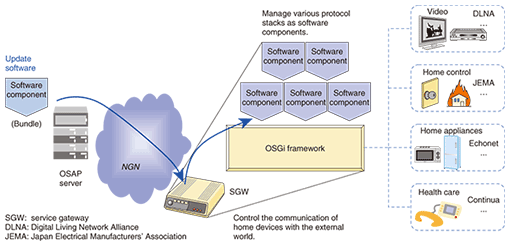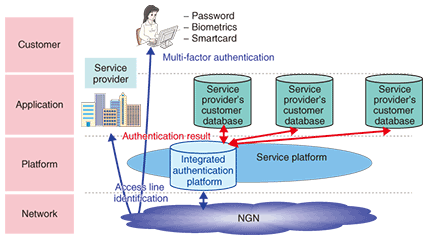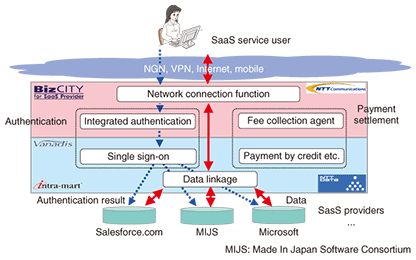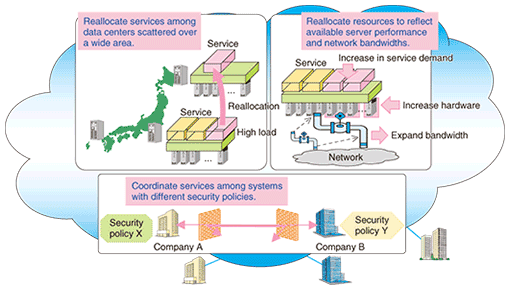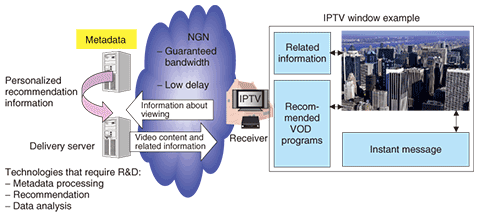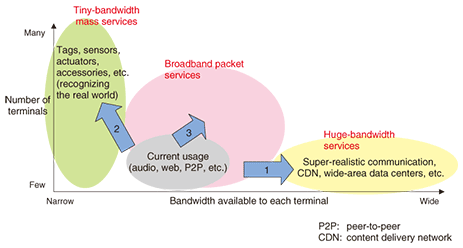 |
|
|
|
|
|
Special Feature: Keynote Speeches at NTT R&D Forum 2009 Vol. 7, No. 4, pp. 13–21, Apr. 2009. https://doi.org/10.53829/ntr200904sf2  NTT’s R&D to Meet the Challenges of ICT Paradigm ShiftsAbstractThis article introduces NTT’s major R&D activities related to the development of services that will be provided on the Next Generation Network (NGN) with a focus on changes taking place in information and communications technology (ICT). It is based on the presentation given by Takashi Hanazawa, Director and Senior Vice President and Director of NTT Research and Development Planning Department, at the NTT R&D Forum 2009 held on February 19–20, 2009. 1. NGN-related activitiesNTT EAST and NTT WEST launched our commercial Next Generation Network (NGN) service in March 2008. Since July 2008, when they began a full-scale effort to expand its service area, the number of subscribers to the NGN has been growing steadily. As shown in Fig. 1, the NGN consists of two layers—a transport layer and a service control layer—and conforms to the IP Multimedia Subsystem (IMS) architecture standardized by ITU-T (International Telecommunication Union, Telecommunication Standardization Sector). The transport layer is based on routers and uses Internet protocol (IP) to transfer packets. The service control layer uses general-purpose servers and manages sessions, quality of service, and security. The IMS international standard embraces ADSL (asymmetric digital subscriber line), optical access, and mobile access for use in the access network, but NTT is building fixed-line and mobile networks separately and aiming to provide seamless services through the interworking of these two networks. For the initial implementation of the NGN, we are building fixed-line access networks using only optical access lines because such a network excels in broadband access capability. The NGN offers the convenience and economy of an IP network while ensuring the quality, security, and reliability that has come to be expected of the telephone network. It can provide a variety of broadband and ubiquitous services through its open interfaces.
An example of how the know-how accumulated through the operation of the telephone network has been used is NTT’s decision to build a hierarchically structured NGN in which all routers that serve customers have redundant routes to higher-level nodes. This network structure ensures network reliability and minimizes delay. It also facilitates traffic design and resource management and lets experience gained from telephone network operation be applied to traffic congestion control in the NGN. 1.1 Promotion of NGN-exploiting businessesThe NGN offers several interfaces. The application server-network interface (SNI) will let as many service providers as possible create new services that can run on the NGN and expand their business through their provision. Service providers can provide services through the SNI either by using a ready-made platform that incorporates pre-developed application components or by directly developing applications by themselves. Although NTT Group companies will collaborate with each other to provide such platforms and application services, we do not believe that businesses on the NGN can flourish with the resources of the NTT Group alone, so we will strive to support other providers in their efforts to pursue business on the SNI. However, the above scheme is not without unanswered issues. First, it is difficult to develop an exhaustive interface specification to meet the requirements of every service when it is impossible to imagine what services will be provided through the SNI in the future. We will continue to reinforce the SNI taking into consideration the various factors involved, such as trends in international standardization, the status of vendors’ implementations, the demands of service providers and end users, NTT’s discretion as to business viability, and regulations. Second, it is necessary to make the SNI functions easy to use. It is important to take every opportunity to explain the SNI specification and to reinforce the set of tools that enables software developers to use the SNI easily. As part of our efforts to make the developmental environment for the SNI widely available, we have invested in Softfront, which has developed a software development kit (SDK) for the session initiation protocol (SIP). 1.2 Conformance to international standardsAs I mentioned, NTT’s NGN conforms to the IMS architecture, an international standard of ITU-T. When 3GPP (3rd Generation Partnership Project), a standardization organization for mobile services, made progress with the study of IP network specifications for mobile services, ETSI (European Telecommunication Standards Institute), a key standardization organization in Europe, decided to apply this specification to the NGN for fixed-line services. In the course of this historical development, NTT expressed its support for the specification. NTT researchers have actively participated in, and made contributions to, not only ITU-T but also other relevant standardization bodies, including 3GPP and ETSI, and have striven to collect the information needed to develop the NGN at an early stage. We have two main objectives in building the NGN. First, we need to have a new network infrastructure that will enable us to provide broadband and ubiquitous services, which we consider to be an important revenue source for carriers. Second, we need to make the transition from the existing fixed-line telephone network to an IP network. This means that we must solve the problem of replacement parts for existing switches becoming unavailable as a result of the suspension of their production. In introducing the NGN under these circumstances, a carrier can take either a replacement strategy or an overlay strategy: (1) Replacement strategy: This strategy emphasizes economical replacement of the telephone network. It involves first replacing the telephone network with an IP network and incorporating control systems (softswitches) into existing switches. Next, the IMS architecture is introduced to provide broadband and ubiquitous services. Although this strategy requires two steps, it is considered effective in reducing the transition cost in the immediate future. (2) Overlay strategy: This strategy emphasizes early provision of broadband and ubiquitous services. The NGN is built independently of the replacement of the telephone network. From the beginning, the NGN is built based on the IMS architecture. NTT has chosen this strategy. NTT Laboratories is engaged in activities to encourage the spread of IMS-based NGNs globally, for example by hosting seminars in Asia. We hear that carriers in developed nations, such as Europe and America, intend to increase their revenues by providing NGN services at an early stage and plan to, or have already started to, introduce IMS. Many Asian countries seem inclined to adopt the replacement strategy because they put priority on the development of the telephone network and consider that it is still too early to provide broadband and ubiquitous services. However, we should not assume that softswitch-based telephone network replacement is still the only option in these countries, considering the decline in the demand for the fixed-line telephone service resulting from the widespread use of mobile phones. Moreover, many Japanese and other foreign companies have business offices in these countries, and it is mainly these offices that are generating the demand for broadband and ubiquitous services. Considering these changes, NTT Laboratories is trying to expand the circle of like-minded carriers by taking various opportunities to encourage other Asian countries to adopt the IMS architecture early on. 1.3 Network for broadband and ubiquitous servicesSince as early as 1979 when NTT announced its INS (information network system) concept, NTT has had, for reasons of economy, a vision of using a single integrated network to provide communication services that handle various media, such as telephony, data, still pictures, and video. Our adoption of ISDN (integrated services digital network) represented the early implementation of this vision. We have also sought to provide broadband services based on this vision. Today, there may be different assessments of these efforts, but it is true that the integrated network failed to bring about groundbreaking change in the industry. In contrast, service integration on the Internet has indeed given rise to new industries. We regard the NGN as a tool that lets telecommunications providers enter this Internet-driven business field, armed with their accumulated knowhow in telecommunications. This means that the potential of the NGN cannot be fully exploited unless our design philosophy puts more weight on broadband and ubiquitous services than on the telephone service. The NGN may appear similar to the integrated multimedia network that has been pursued conventionally by telecommunications providers. However, the market environment and the technologies used today have completely changed since the ISDN age. I believe that the NGN will usher in an era of new businesses. 1.4 Managed networksThe Internet and the NGN have many technical features in common. They both use IP. However, their basic philosophies, and consequently the role of the network and the conditions for using it, are completely different. While the Internet may be described as a stupid network on the basis of the idea that complicated functions should be implemented outside the network, the NGN is a managed network. We believe that a mechanism to assure quality, security, and reliability is essential for a network used in the business environment. In other words, the technology used in the Internet needs to be improved if it is to meet the requirements of the era when broadband and ubiquitous services are widely used. We do not mean that one or the other is wrong. Since their basic philosophies are different, it is only natural that the two networks should have been designed differently. At the time we launched R&D on the NGN, we wondered if it was appropriate to build a network based on a philosophy different from that of the Internet. The reason we were able to come to a conclusion with confidence was that NTT Laboratories had been studying the Internet from its early days, so telecommunications-minded people were able to hold discussions with those who lived in the Internet culture. We gained confidence that we were not being self-righteous, but instead only humbly thinking of what the future network should be like. By 1984 when JUNET, the pioneer Internet in Japan, was launched, NTT Laboratories already had an internal TCP/IP (transmission control protocol, Internet protocol) community. JUNET was connected to NTT’s IP network in 1987. It was reported that the first Japanese organization that bought routers from Cisco Systems in the USA was NTT Laboratories. The researchers involved in those endeavors later made a tremendous contribution to starting the project on the OCN, the NTT Group’s ISP (Internet service provider) service and the project on the IPv6 (Internet protocol version 6) network. We believe that the Internet and NGN are not in a conflict where one is seeking to displace the other. Both are fit to provide services of different types. Their relation is both competitive and complementary, with each seeking to exploit its specific characteristics. With these two networks co-existing, users can choose services appropriate for their needs, and service providers can choose the manner of service provision that is optimal for the characteristics of their individual services (Fig. 2).
2. R&D for ICT paradigm shiftsWe think that three momentous paradigm shifts are in progress in the world of information communication: - Shift to service convergence - Shift from owning to renting - Shift to user-centric services. Let me introduce NTT’s R&D activities regarding service development on the future NGN from the perspective of how they are affected by these shifts in ICT. 2.1 Shift to service convergence: renewal of the value chainThe shift to service convergence can be interpreted as the renewal of the conventionally established value chain. As consumers have come to play a more active role in the market, and the market has become more open, new collaborative relationships are being formed between different enterprises, between different industries, and between industry and consumers. These new relations go beyond the conventional framework of the value chain. In other words, a revolution in the conventional value chain is taking place. This shift highlights the importance of two technical platforms: (i) the platform for the consumer’s ICT environment, such as a home network that can adapt quickly to application services provided by different players and (ii) the platform that promotes interworking between these application services. In other words, there is a need to develop common environments on both the server and terminal sides to facilitate application development and entry into new business markets. 2.1.1 Platform for consumer’s ICT environmentSince a home network is assumed to be used to control home appliances and home security, its most important function is to ensure security, such as preventing unauthorized access and protecting privacy. A unique feature of the NGN is its ability to identify the access line used when it receives signals from a customer and to assign an IP address to the line on the basis of this information. If it receives packets from an IP address it has not assigned, it can discard those packets. This mechanism prevents mischievous acts or crimes, such as spoofing. The low-delay feature of the NGN is useful for control functions that require realtime processing. With its characteristics of high security, realtime processing, and low packet-loss as well as high reliability, the NGN is well equipped to provide platform services, SaaS (software as a service), and personalized services. The second feature required for a home network is interconnectivity and ease of operation and adjustment of settings. If it were necessary to develop mechanisms for connecting terminals or updating software individually for each service, the total cost would be too high to encourage the widespread use of these services. Moreover, if it were difficult to install new terminals or change terminal settings to introduce a new service, it would be difficult to promote service convergence. To solve these problems, we are actively developing and promoting the use of a platform called OSAP (OSGi* Service Aggregation Platform) (Fig. 3). Our aim is to let the end user receive a service simply by connecting the relevant terminal to his or her home network and to let the service provider provide a new service simply by downloading relevant software from an OSAP server to end users.
2.1.2 Platform for interworking between application servicesTo promote service convergence, it is necessary to develop mechanisms that assist service interworking. One important mechanism is to enable services to share authentication information. NTT Laboratories is studying a multi-factor authentication system that allows the NGN’s robust security feature of access line identification to be used in combination with other types of authentication (Fig. 4).
2.2 Shift from owning to rentingThe second paradigm shift is from owning to renting. Users are increasingly finding it a heavy burden to bear the cost of owning an information system, with the initial investment in system construction, the running costs for maintaining and managing software, and the trouble involved in adding or removing resources in response to an increase or decrease in demand. In parallel with this shift, there have been new developments in the technologies and environment for using services over a network, such as the widespread availability of broadband access, the virtualization of servers, and improvements in the customizability and operability of shared environments. A representative solution to this problem is SaaS, in which the user terminal runs only simple input/output software, such as a web browser, and actual processing and data storage are performed in a data center. However, potential SaaS users have had apprehensions about leaving important data in the hands of an outside company because of concerns about data security and network availability. These concerns have been a barrier to the widespread use of SaaS. 2.2.1 Activities for promoting SaaS over NGNTo resolve such apprehensions, NTT is working on SaaS over NGN. This provides, in the form of a platform, a set of capabilities (including high security based on the NGN’s ability to identify the access line used), a highly reliable means of access, and the functions required by SaaS providers. A SaaS platform for enterprises is shown in Fig. 5. It was developed jointly by NTT Communications and NTT DATA as part of their activities to build a fully fledged SaaS platform. This platform provides a one-stop service that offers all the various functions required by SaaS providers, such as authentication, payment settlement, billing and collection, and data linkage.
2.2.2 Activities related to core technologies for cloud computingIf we are to provide SaaS applications and platforms on a large scale, we need a high-capacity high-reliability (i.e., carrier-grade) cloud computing platform (Fig. 6). The NTT Group’s know-how in this technical area may have been somewhat limited in the past. However, if we are to provide SaaS-related businesses and user-centric services, we must accumulate technical know-how in this area. To this end, we have launched R&D into this area and have been driving this activity aggressively. We are striving to achieve the functionality, performance, and reliability required for cloud computing at a low cost and with a low impact on the environment by collaborating with partners who have relevant technologies, by making use of technologies available on the market and open source software, and by incorporating the R&D results of NTT Laboratories.
2.3 Shift to user-centric services The third paradigm shift is a shift to user-centric services. We expect to see an increase in the use of context-aware services, namely personalized services that are adapted to the user’s context, such as his or her interests, preferences, and surrounding conditions. An example of such a service is NTT DOCOMO’s The Internet White Paper published by the Internet Association Japan reports that their survey on problems resulting from malicious actions over the Internet found that many users have apprehensions about their highly confidential, personal information being handled over the Internet. Since the information used in a personalized service is indeed highly confidential personal information, we must find and implement ways to eliminate such apprehensions and thereby encourage the use of personalized services. We believe that the NGN’s strengths—high security, high reliability, low delay, and high quality—can be a key to promoting the growth of personalized services. One personalized service being studied at NTT Laboratories is a personalized IPTV (Internet protocol television) viewing service (Fig. 7). It provides, on a TV display, a list of recommended programs selected on the basis of the user’s attributes, viewing history, and type of content currently being viewed. This service can also invite the user to visit e-commerce sites that match his or her interests.
3. R&D activities with a long view3.1 Ultimate context-awarenessIn 2000, NTT Laboratories announced a vision of Informative Ambience, which signaled the convergence of the virtual and real worlds with information becoming a part of the daily living environment. In 2007, as a vision of one service that can be implemented using this Informative Ambience, we proposed the concept of a knowledge sharing service, which was described by the slogan: “personalized knowledge for you, right here and now”. The personalized or context-aware services are forerunners of the knowledge sharing service. Based on this vision, NTT Laboratories will continue its long-term development and research into the technical elements needed to implement it. We are undertaking research into the multi-faceted technologies that will be needed to make the knowledge sharing service a reality. For example, in terms of quantitative performance, we are aiming to achieve stable operation of a global-scale server system; in terms of qualitative achievements, we are studying how to search the archive of a person’s lifetime video and audio data in a matter of a second; and from the perspective of naturalness, we are researching communication based on all five human senses. These studies require know-how in technical areas where NTT Laboratories is highly competent, such as technologies for audio and video encoding, Japanese language processing (including searching), security (including encryption), and image processing. We will maintain and further develop our competence in these areas. 3.2 Directions of network services for 2020To make Informative Ambience a reality, we must enable network services to support broader bandwidths and an enormous number of terminals. It will not be feasible for a single network service to meet these requirements. Instead, it will be better to divide services into three groups: tiny-bandwidth mass services (TMS), broadband packet services (BPS), and huge-bandwidth services (HBS), as shown in Fig. 8. The underlying support for these network services will be provided by an all-optical network. It is important to study how to virtualize this network to bring these three groups of services to reality (Fig. 9).
Wireless technology is crucial for accommodating an enormous number of terminals. It is important to study how to bring about the convergence of optical and wireless networks, how to ensure that a great variety of terminals can be easily connected to networks, and how to manage these terminals. It is also important to develop a network control scheme that enables the network to respond quickly to changes in traffic, network failures, and modifications to network functions. At present, an intensive study is being carried out mainly by NICT (National Institute of Information and Communications Technology) on a so-called new generation network, which is a network for the post-NGN era. NTT Laboratories will press forward with research into future networks in coordination with the studies at the national level and will contribute to those studies. 4. ConclusionService creation will help the NTT Group expand its business and contribute to the development of society at large. NTT’s R&D is committed to play its part in this endeavor, making the most of its strengths without insisting on using only in-house-developed technologies. |
|










